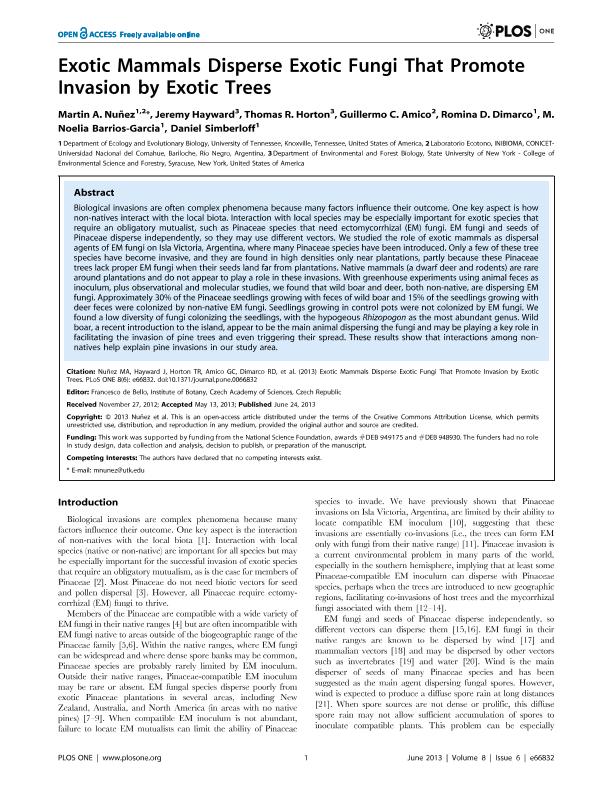Artículo
Exotic Mammals Disperse Exotic Fungi That Promote Invasion by Exotic Trees
Nuñez, Martin Andres ; Hayward, Jeremy; Horton, Thomas R.; Amico, Guillermo Cesar
; Hayward, Jeremy; Horton, Thomas R.; Amico, Guillermo Cesar ; Dimarco, Romina Daniela
; Dimarco, Romina Daniela ; Barrios Garcia, M. Noelia; Simberloff, Daniel
; Barrios Garcia, M. Noelia; Simberloff, Daniel
 ; Hayward, Jeremy; Horton, Thomas R.; Amico, Guillermo Cesar
; Hayward, Jeremy; Horton, Thomas R.; Amico, Guillermo Cesar ; Dimarco, Romina Daniela
; Dimarco, Romina Daniela ; Barrios Garcia, M. Noelia; Simberloff, Daniel
; Barrios Garcia, M. Noelia; Simberloff, Daniel
Fecha de publicación:
06/2013
Editorial:
Public Library Of Science
Revista:
Plos One
ISSN:
1932-6203
Idioma:
Inglés
Tipo de recurso:
Artículo publicado
Clasificación temática:
Resumen
Biological invasions are often complex phenomena because many factors influence their outcome. One key aspect is how non-natives interact with the local biota. Interaction with local species may be especially important for exotic species that require an obligatory mutualist, such as Pinaceae species that need ectomycorrhizal (EM) fungi. EM fungi and seeds of Pinaceae disperse independently, so they may use different vectors. We studied the role of exotic mammals as dispersal agents of EM fungi on Isla Victoria, Argentina, where many Pinaceae species have been introduced. Only a few of these tree species have become invasive, and they are found in high densities only near plantations, partly because these Pinaceae trees lack proper EM fungi when their seeds land far from plantations. Native mammals (a dwarf deer and rodents) are rare around plantations and do not appear to play a role in these invasions. With greenhouse experiments using animal feces as inoculum, plus observational and molecular studies, we found that wild boar and deer, both non-native, are dispersing EM fungi. Approximately 30% of the Pinaceae seedlings growing with feces of wild boar and 15% of the seedlings growing with deer feces were colonized by non-native EM fungi. Seedlings growing in control pots were not colonized by EM fungi. We found a low diversity of fungi colonizing the seedlings, with the hypogeous Rhizopogon as the most abundant genus. Wild boar, a recent introduction to the island, appear to be the main animal dispersing the fungi and may be playing a key role in facilitating the invasion of pine trees and even triggering their spread. These results show that interactions among non-natives help explain pine invasions in our study area.
Palabras clave:
Na
Archivos asociados
Licencia
Identificadores
Colecciones
Articulos(INIBIOMA)
Articulos de INST. DE INVEST.EN BIODIVERSIDAD Y MEDIOAMBIENTE
Articulos de INST. DE INVEST.EN BIODIVERSIDAD Y MEDIOAMBIENTE
Articulos(SEDE CENTRAL)
Articulos de SEDE CENTRAL
Articulos de SEDE CENTRAL
Citación
Nuñez, Martin Andres; Hayward, Jeremy; Horton, Thomas R.; Amico, Guillermo Cesar; Dimarco, Romina Daniela; et al.; Exotic Mammals Disperse Exotic Fungi That Promote Invasion by Exotic Trees; Public Library Of Science; Plos One; 8; 6; 6-2013; 66832-66832
Compartir
Altmétricas



